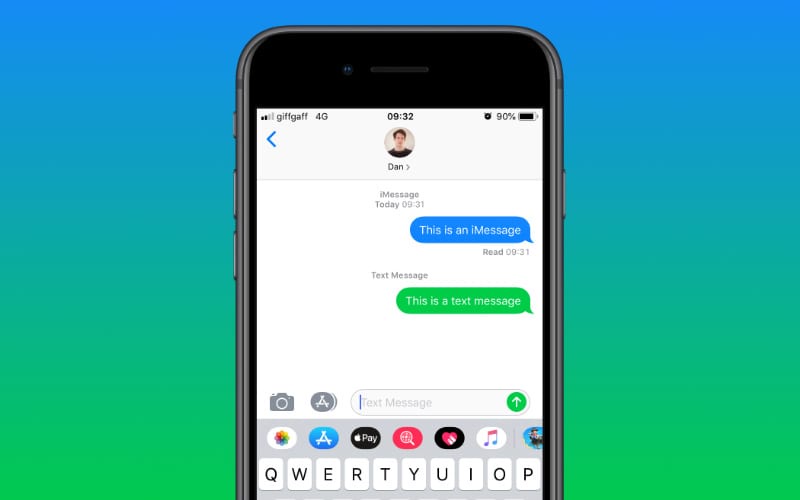Most of us are familiar with iMessage. If you have an Apple device you’ve almost certainly used it. iMessage is the app that allows you to send texts to and from various Apple devices like the iPhone, iPad, Mac and Apple Watch. Launched in 2011, the app comes as standard with Apple’s line of products and since it’s release has shown itself to be a leader in its field, batting off competitors like Whatsapp, Facebook Messenger and Viber. Considering these were originally built by companies whose sole purpose was to create the best messaging app possible, it’s pretty impressive that iMessage surpassed all of its competitors and remains popular today.
In fact, some may have expected Apple to put messaging on the back burner while focusing on more important iOS features. But they took the exact opposite approach and it’s really paid off.
People have cited iMessage as the primary reason why they continue to buy iPhones. But why is iMessage so popular and what makes it so much better than Android? Well, that’s exactly what I’m going to explain in this article.
Now let’s start with one of the most important features of iMessage. It’s SMS fallback. Do you know how sometimes you send a message that usually would be blue, but had trouble sending and appears as a green message instead? That’s iMessage using SMS as a backup to make sure your text is delivered. There’s a variety of reasons why that happens, but the point is that it does happen. Instead of telling you that the message couldn’t be delivered. But there’s another way iMessage uses SMS that makes your life easier. It switches seamlessly between iMessage conversations with other Apple users and SMS conversations with Android users.
It automatically chooses the right protocol to use without you even thinking about it. And that’ll be a common theme throughout, the seamlessness and self-management of iMessage, compared to the fragmentation and user-management of Android messaging apps. Which serves as a great representation of the philosophies behind each platform. Android users rail against Apple’s exclusivity and closed operating system, but they fail to recognize the benefits of that approach.
An iPhone user unboxes their phone, logs in to their iCloud account, and moves on with their life. Android users unbox their phone, removes the preloaded manufacturer bloatware, optimizes battery settings based on their usage, manually downloads their favourite apps including a messaging client like WhatsApp, logs in to their accounts associated with each app, install their preferred user interface skin, and hopes that no data is lost in the process.
For most people, the Android approach isn’t some great opportunity to customize their smartphone experience, it’s just a pain in the butt. And those opposing philosophies are demonstrated perfectly with the messaging experience on each platform.
For example, iPhone users wake up in the morning and reply to messages on their iPhone, sit at their desk and continue the conversation on their Mac, take a walk outside and send messages from their Apple Watch, and then reply to messages on the couch with their iPad.
Everything automatically stays in sync, across all their devices, without even thinking about it. And for most Apple users, this probably sounds obvious. But on Android, it’s extremely difficult and sometimes impossible for users to set up such a seamless messaging experience.
For most people, that’s a dealbreaker. And it’s why Apple users don’t leave the ecosystem. And when it comes to Android users complaining about iOS, they often criticize Apple for introducing features much later. But iMessage has had read receipts and a typing indicator since 2011. A capability that was just added to Android with Google RCS in 2019.
And these are just basic functions of a messaging app. And while Android is still struggling to perform them well, Apple has moved on to bigger and better things. Like an App Store exclusive to iMessage. Where you can play games, translate text, scan documents, search movies, and even watch sports highlights all from within the messaging app. Which Android is probably on pace to implement a few decades from now. There’s also features that just make iMessage more fun to use like Animoji and Memoji, not to mention a seamless implementation of voice messages, Audio calling, and FaceTime, that no app on Android could even compete with.
Alright now Google did release their RCS messaging app in late 2019 that has things like read receipts, real-time reply indicators, and interactive media, but the app wasn’t enabled by default. Just look at this article by Mark Jansen detailing how to set up the app on Android:
“First of all, make sure you’re using Google Messages as your main text messaging app. Some phones, like those running Android One or Google’s Pixels, will already have Google Messages as the default messaging app. If your settings are something else, easily change it by going to the Settings app, then hitting Apps and notifications > Advanced > Default apps > SMS app. Then, select the Messages app as your default. If you don’t have it, first download the Messages app from the Play Store. It will ask you to set it as the default messaging app once you launch it.
Next, you’ll want to open the Messages app’s settings. Do this by tapping the three vertical dots in the upper-right corner.
Select Settings, then tap Chat features. Finally, Enable chat features to turn RCS messaging on. Tapping this option will cause a new bar to appear. It will show the message Setting up. Setup will take a few seconds, and then the message will change to Connected. If you can’t configure your phone, tap Setting up and try again. Make sure that your phone carrier offers RCS and that it’s available in your region.”
Now that sounds like the seamless and effortless experience users can expect from Android. And just keep in mind, those are the steps to set up just one app. Not the entire operating system. And even if you use Google’s RCS app, you won’t be able to enjoy its features if the recipient hasn’t also set up Google RCS. Which is a huge problem considering Google can’t force manufacturers like Samsung to set RCS as their phone’s default messaging app.
And this creates a vicious cycle that prevents adoption. According to some users comments on Reddit threads about RCS usage. One said, "I can tell you that only 1 out of about 60 of my regular contacts are using RCS. The rest are using mostly SMS or iPhones. The one person who had it turned on had no idea what RCS is or how it got activated.” Another said “Most tech-savvy people will know RCS and how to turn it on. But at the same time, they do not bother to switch from whatever message apps they are currently using.” And lastly “I've tried RCS but find it useless! Because almost every person I know has an iPhone, so I just went back to Textra.”
This is the story of almost every attempt Google has made at making Android a less fragmented platform. And it’s why iOS will always be the choice of everyday users who just want products that work well, with as little frustration as possible. And this isn’t even considering one of the biggest strengths of iMessage, it’s end-to-end encryption. Which is also an extension of iOS as a whole. Apple places much more emphasis on security and privacy than any other tech company. And because iOS is a closed system, they have total control over their own apps and third-party apps do with your data.
Whereas Android apps are known for sucking as much user data into the cloud as possible, with Google having little control over-regulation. So call me an Apple sheep, but until I can seamlessly send messages across my Galaxy S20, Dell PC, Amazon tablet, and Samsung watch, I’m sticking with Apple.
Alright, guys thanks for reading I'll see you around.


No comments yet